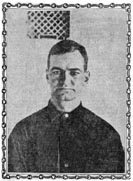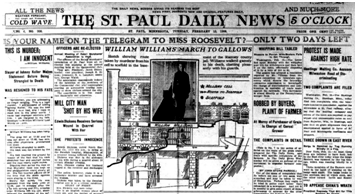Bungled St. Paul Hanging was State's Last Execution
Provided to the Saint Paul Police Historical Society by reporter Nick Woltman.
Originally printed in the St. Paul Pioneer Press on Saturday, February 13, 2016
By Nick Woltman
nwoltman@pioneerpress.com

William F. Williams
It took William F. Williams more than 14 excruciating minutes to die when he was hanged in the basement of the Ramsey County Jail on Feb. 13, 1906.
The rope stretched and his feet hit the floor when the trap was sprung, according to a report in that afternoon's issue of the St. Paul Daily News. Three Ramsey County sheriff's deputies standing on the scaffold above had to pull up on the rope while Williams slowly strangled.

The St. Paul Daily News; Vol. 6, No. 300
Tuesday, February 13, 19061
Price One Cent
A 27-year-old English immigrant convicted of murdering his male teenage lover, Williams was the last person executed in Minnesota. His botched hanging helped turn public sentiment against the practice, which drove the state Legislature to abolish the death penalty in 1911.
"Gentlemen, you are witnessing an illegal hanging," Williams said from the gallows, still insisting he was innocent. "I am accused of killing Johnny Keller. He was the best friend I ever had."
Williams and Keller met in 1903 as patients at a St. Paul hospital where they were being treated for diphtheria, the [Daily News] reported at the time. They soon developed a romantic relationship.
Despite the objections of the boy's parents, Williams and Keller spent two years living and traveling together. When Keller tried to end the relationship in April 1905, an enraged Williams went to the family's St. Paul apartment and fatally shot the boy and his mother.
Williams' sensational trial coincided with that of another infamous St. Paul killer named Edward Gottschalk, who was described by the Daily News as "archfiend of the year" for his part in the grisly murder of a local butcher. The city's newspapers covered both cases from start to finish. Williams and Gottschald were both sentenced to death by hanging, but Gottschalk "cheated the gallows as he had promised by hanging himself in his cell," the Daily News reported.
Williams, only the fifth person hanged in Ramsey County history, spent much of his last day on Earth playing cards with his guards, whom he befriended while awaiting execution. The wife of Ramsey County Sheriff Anton Miesen prepared Williams a last meal of steak, German fried potatoes, desert and coffee.
Miesen himself had tested the gallows the day before by swinging from the rope, but he failed to recognize "the grim but elementary law of physics that if weight is applied to a rope and to a human neck, both will stretch," wrote Walter Trenerry in his 1962 book "Murder in Minnesota."
Reporters were barred from attending the execution, but Daily News reporter Joseph E. Hennessey managed to sneak in among the crowd of 32 witnesses.
Williams "was the coolest man in the room" as he "walked manfully and bravely" up the 13 steps to the scaffold, Hennessey wrote.
After his last words, a hood was placed over his head and the lever pulled.
Williams' attorney called the execution "a disgrace to civilization." Newspapers compared execution by hanging to the Inquisition tortures of the Middle Ages, Trenerry wrote.
Five years later, the Minnesota Legislature voted to abolish the death penalty, and on April 22, 1911, Gov. Adolph Eberhart signed the bill into law.
1 Available via microfilm at the St. Paul Public Library and/or the Minnesota History Center.
Pioneer Press Reporter Molly Guthrey contributed to this report.
"The St. Paul Daily News" article was inserted by
SPPHS member Ed Steenberg.
